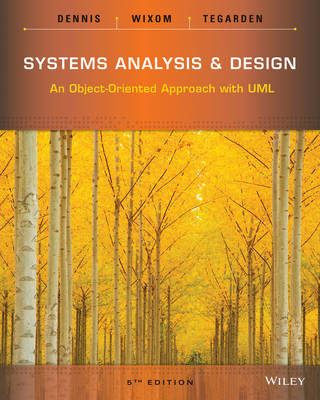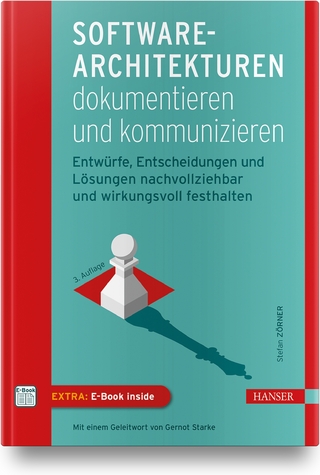
Systems Analysis and Design
John Wiley & Sons Inc (Verlag)
978-1-118-80467-4 (ISBN)
- Titel erscheint in neuer Auflage
- Artikel merken
Systems Analysis and Design: An Object-Oriented Approach
with UML, 5th Edition by Dennis, Wixom, and
Tegarden captures the dynamic aspects of the field by keeping
students focused on doing SAD while presenting the core set of
skills that every systems analyst needs to know today and in the
future.
The text enables students to do SAD?not just
read about it, but understand the issues so they can actually
analyze and design systems. The text introduces each major
technique, explains what it is, explains how to do it, presents an
example, and provides opportunities for students to practice before
they do it for real in a project. After reading each chapter, the
student will be able to perform that step in the system development
process.
Dr. Alan R. Dennis is a professor of internet systems at Indiana University. He has written over 60 journal articles and has published 4 books. He is the senior editor for the MIS Quarterly and also serves on the editorial board for the Journal of MIS, Association for MIS, Computer Mediated Communication and the International Journal of e-Collaboration.
Chapter 1 Introduction to Systems Analysis and Design 1
Introduction 1
The Systems Development Life Cycle 2
Planning 3
Analysis 3
Design 4
Implementation 4
Systems Development Methodologies 5
Structured Design 6
Rapid Application Development (RAD) 8
Agile Development 12
Selecting the Appropriate Development Methodology 15
Typical Systems Analyst Roles and Skills 17
Business Analyst 18
Systems Analyst 18
Infrastructure Analyst 18
Change Management Analyst 19
Project Manager 19
Basic Characteristics of Object-Oriented Systems 19
Classes and Objects 19
Methods and Messages 20
Encapsulation and Information Hiding 20
Inheritance 21
Polymorphism and Dynamic Binding 22
Object-Oriented Systems Analysis and Design (OOSAD) 23
Use-Case Driven 24
Architecture-Centric 24
Iterative and Incremental 24
Benefits of Object-Oriented Systems Analysis and Design 25
The Unified Process 25
Phases 26
Workflows 28
Extensions to the Unified Process 30
The Unified Modeling Language 34
Applying the concepts at Patterson superstore 36
Chapter Review 36
Chapter 2 Project Management 41
Introduction 41
Project Identification 43
System Request 44
Feasibility Analysis 45
Technical Feasibility 45
Economic Feasibility 46
Organizational Feasibility 51
Project Selection 53
Traditional Project Management Tools 54
Work Breakdown Structures 55
Gantt chart 56
Network Diagram 57
Project Effort Estimation 58
Creating and Managing the Workplan 63
Evolutionary Work Breakdown Structures and Iterative Workplans 63
Managing Scope 67
Timeboxing 68
Refining Estimates 69
Managing Risk 70
Staffing the Project 71
Characteristics of a Jelled Team 71
Staffing Plan 73
Motivation 75
Handling Conflict 76
Environment and Infrastructure Management 76
CASE Tools 77
Standards 77
Documentation 78
Applying the Concepts at Patterson Superstore 80
Chapter Review 80
PART ONE ANALYSIS MODELING 85
Chapter 3 Requirements Determination 86
Introduction 86
Requirements Determination 87
Defining a Requirement 87
Requirements Definition 89
Determining Requirements 89
Creating a Requirements Definition 91
Real-World Problems with Requirements Determination 91
Requirements Analysis Strategies 92
Problem Analysis 92
Root Cause Analysis 92
Duration Analysis 93
Activity-Based Costing 94
Informal Benchmarking 94
Outcome Analysis 95
Technology Analysis 95
Activity Elimination 95
Requirements-Gathering Techniques 95
Interviews 96
Joint Application Development (JAD) 100
Questionnaires 104
Document Analysis 106
Observation 108
Selecting the Appropriate Techniques 108
Alternative Requirements Documentation Techniques 110
Concept Maps 110
User Stories 112
The System Proposal 113
Applying the Concepts at Patterson
Superstore 114
Chapter review 114
Chapter 4 Business Process and Functional Modeling 119
Introduction 119
Business Process Identification with Use Cases and Use-Case Diagrams 121
Elements of Use-Case Diagrams 121
Identifying the Major Use Cases 126
Creating a Use-Case Diagram 127
Business Process Modeling with Activity Diagrams 129
Elements of an Activity Diagram 131
Guidelines for Creating Activity Diagrams 136
Creating Activity Diagrams 137
Business Process Documentation with Use Cases and Use-Case Descriptions 140
Types of Use Cases 141
Elements of a Use-Case Description 141
Guidelines for Creating Use-Case Descriptions 145
Creating Use Case Descriptions 146
Verifying and Validating the Business
Processes and Functional Models 153
Verification and Validation through Walkthroughs 153
Functional Model Verification and Validation 154
Applying the Concepts at Patterson Superstore 157
Chapter Review 157
Chapter 5 Structural Modeling 163
Introduction 163
Structural Models 164
Classes, Attributes, and Operations 164
Relationships 165
Object Identification 166
Textual Analysis 166
Brainstorming 167
Common Object Lists 169
Patterns 169
Crc Cards 172
Responsibilities and Collaborations 172
Elements of a CRC Card 173
Role-Playing CRC Cards with Use Cases 174
Class Diagrams 176
Elements of a Class Diagram 176
Simplifying Class Diagrams 184
Object Diagrams 184
Creating Structural Models Using CRC Cards and Class Diagrams 185
Campus Housing Example 187
Library Example 187
Verifying and Validating the Structural Model 194
Applying the Concepts at Patterson Superstore 197
Chapter Review 198
Chapter 6 Behavioral Modeling 202
Introduction 202
Behavioral Models 203
Interaction Diagrams 204
Objects, Operations, and Messages 204
Sequence Diagrams 204
Communication Diagrams 216
Behavioral State Machines 221
States, Events, Transitions, Actions, and Activities 221
Elements of a Behavioral State Machine 222
Creating a Behavioral State Machine 226
Crude Analysis 229
Verifying and Validating the Behavioral Model 233
Applying the Concepts at Patterson Superstore 235
Chapter Review 235
PART TWO DESIGN MODELING 239
Chapter 7 Moving on to Design 240
Introduction 240
Verifying and Validating the Analysis Models 242
Balancing Functional and Structural Models 242
Balancing Functional and Behavioral Models 243
Balancing Structural and Behavioral Models 251
Summary 254
Evolving the Analysis Models into Design Models 257
Factoring 257
Partitions and Collaborations 258
Layers 259
Packages and Package Diagrams 262
Guidelines for Creating Package Diagrams 264
Creating Package Diagrams 266
Verifying and Validating Package Diagrams 266
Design Strategies 268
Custom Development 268
Packaged Software 269
Outsourcing 270
Selecting a Design Strategy 272
Selecting an Acquisition Strategy 273
Alternative Matrix 274
Applying the Concepts at Patterson Superstore 276
Chapter Review 276
Chapter 8 Class and Method Design 280
Introduction 280
Review of the Basic Characteristics of Object Orientation 282
Classes, Objects, Methods, and Messages 282
Encapsulation and Information Hiding 282
Polymorphism and Dynamic Binding 282
Inheritance 284
Design Criteria 286
Coupling 286
Cohesion 289
Connascence 292
Object Design Activities 293
Adding Specifications 293
Identifying Opportunities for Reuse 294
Restructuring the Design 297
Optimizing the Design 298
Mapping Problem-Domain Classes to Implementation Languages 300
Constraints and Contracts 304
Types of Constraints 306
Elements of a Contract 306
Method Specification 314
General Information 314
Events 314
Message Passing 315
Algorithm Specifications 316
Example 318
Verifying and Validating Class and Method Design 319
Applying the Concepts at Patterson Superstore 322
Chapter review 322
Chapter 9 Data Management Layer Design 326
Introduction 326
Object Persistence Formats 327
Sequential and Random Access Files 327
Relational Databases 330
Object-Relational Databases 332
Object-Oriented Databases 332
NoSQL Data Stores 333
Selecting an Object Persistence Format 335
Mapping Problem Domain Objects to Object Persistence Formats 337
Mapping Problem Domain Objects to an OODBMS Format 338
Mapping Problem Domain Objects to an ORDBMS Format 341
Mapping Problem Domain Objects to a RDBMS Format 344
Optimizing Rdbms-Based Object Storage 346
Optimizing Storage Efficiency 347
Optimizing Data Access Speed 351
Estimating Data Storage Size 356
Designing Data Access and Manipulation Classes 357
Nonfunctional Requirements and Data Management Layer Design 360
Verifying and Validating the Data Management Layer 361
Applying the Concepts at Patterson Superstore 362
Chapter Review 362
Chapter 10 Human–Computer Interaction Layer Design 367
Iintroduction 367
Principles for User Interface Design 368
Layout 369
Content Awareness 369
Aesthetics 370
User Experience 371
Consistency 371
Minimizing User Effort 372
User Interface Design Process 372
Use Scenario Development 373
Navigation Structure Design 375
Interface Standards Design 376
Interface Design Prototyping 377
Interface Evaluation 380
Common Sense Approach to User Interface Design 382
Navigation Design 383
Basic Principles 383
Types of Navigation Controls 384
Messages 386
Navigation Design Documentation 387
Input Design 387
Basic Principles 387
Types of Inputs 390
Input Validation 391
Output Design 392
Basic Principles 392
Types of Outputs 394
Media 394
Mobile Computing and User Interface Design 395
Social Media and User Interface Design 398
Games, Multi-Dimensional Information Visualizations, and Immersive Environments 400
Games, Gamification, and User Interface Design 400
Multidimensional Information Visualization Design 402
User Interface Design and Immersive Environments 404
International and Cultural Issues and User Interface Design 406
Multilingual Requirements 406
Color 407
Cultural Differences 407
Nonfunctional Requirements and Human-Computer Interaction Layer Design 410
Applying the Concepts at Patterson
Superstore 411
Chapter review 411
Chapter 11 Physical Architecture Layer Design 418
Introduction 418
Elements of the Physical Architecture Layer 419
Architectural Components 419
Server-Based Architectures 420
Client-Based Architectures 420
Client–Server Architectures 421
Client–Server Tiers 422
Selecting a Physical Architecture 424
Cloud Computing 426
Ubiquitous Computing and the Internet of Things 428
Green IT 431
Infrastructure Design 432
Deployment Diagram 432
Network Model 434
Hardware and System Software Specifications 438
Nonfunctional Requirements and Physical Architecture Layer Design 440
Operational Requirements 441
Performance Requirements 442
Security Requirements 444
Cultural and Political Requirements 447
Synopsis 448
Verifying and Validating the Physical Architecture Layer 449
Applying the Concepts at Patterson Superstore 450
Chapter Review 450
PART THREE CONSTRUCTION, INSTALLATION, AND OPERATIONS 455
Chapter 12 Construction 456
Introduction 456
Managing Programming 457
Assigning Programmers 457
Coordinating Activities 458
Managing the Schedule 458
Cultural Issues 460
Developing Documentation 462
Types of Documentation 463
Designing Documentation Structure 463
Writing Documentation Topics 465
Identifying Navigation Terms 465
Designing Tests 467
Testing and Object Orientation 468
Test Planning 469
Unit Tests 471
Integration Tests 475
System Tests 476
Acceptance Tests 477
Applying the Concepts at Patterson Superstore 478
Chapter Review 478
Chapter 13 Installation and Operations 481
Introduction 481
Cultural Issues and Information Technology Adoption 483
Conversion 485
Conversion Style 486
Conversion Location 486
Conversion Modules 487
Selecting the Appropriate Conversion Strategy 488
Change Management 489
Understanding Resistance to Change 490
Revising Management Policies 491
Assessing Costs and Benefits 492
Motivating Adoption 493
Enabling Adoption: Training 495
Post-Implementation Activities 497
System Support 497
System Maintenance 498
Project Assessment 500
Applying the Concepts at Patterson Superstore 502
Chapter Review 502
Index 507
| Erscheint lt. Verlag | 21.4.2015 |
|---|---|
| Verlagsort | New York |
| Sprache | englisch |
| Maße | 202 x 251 mm |
| Gewicht | 864 g |
| Themenwelt | Informatik ► Software Entwicklung ► UML |
| Mathematik / Informatik ► Informatik ► Theorie / Studium | |
| ISBN-10 | 1-118-80467-8 / 1118804678 |
| ISBN-13 | 978-1-118-80467-4 / 9781118804674 |
| Zustand | Neuware |
| Informationen gemäß Produktsicherheitsverordnung (GPSR) | |
| Haben Sie eine Frage zum Produkt? |
aus dem Bereich



